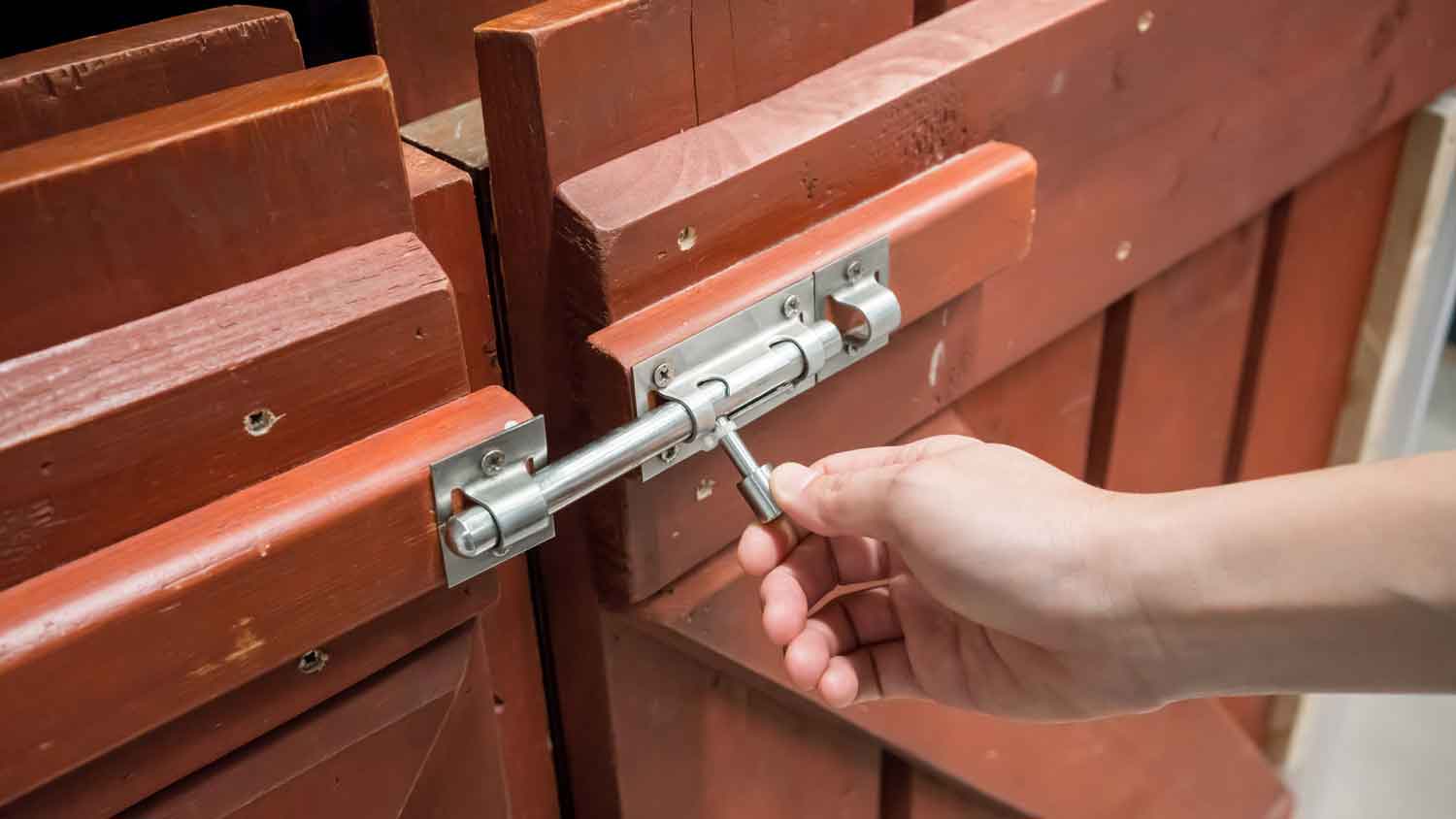How to Install a Latch On a Gate in 5 Quick Steps
Install a new latch for a quick, easy upgrade


- Impact driver
- Socket set
- Socket attachment
- Drill
- Punch
- Gate latch and hardware
- Carpenter’s pencil
We’ve all struggled with a gate latch that doesn’t quite work right. Luckily, learning how to install a latch on a gate is a quick and straightforward DIY job. Besides being a minor annoyance, it can cause more significant problems if your gate is accidentally left open. Find out how to secure your gate in five easy steps.
Prepping to Install a Latch On a Gate

First, you’ll need to determine which latch type you want to use. There are many options available to fit your needs and the type of gate you have.
The most basic type of gate latch is the fingertip-release latch. These work well but don’t offer any self-closing features, so you may accidentally leave your gate hanging open once in a while. Another basic latch type is the slide bolt, which is more secure.
It’s not uncommon for a fingertip-release latch to slam closed without the latch fully engaging. In this case, the door remains open. But with a slide bolt, you’ll know with total certainty that you’ve closed it.
If you have kids or pets or just simply don’t want to deal with having to manually shut the gate every time, then you should opt for a self-closing or spring-loaded latch. Commonly, thumb-and-level latches are spring-loaded. Other easier options to open and close are ring or handle latches.
The sturdiest, most secure gate latches are ones with built-in locks. Some of these are magnetic and usually easy to install.
These latches range from $5 for a basic, fingertip-release latch all the way up to $100 or more for magnetic-locking latches. However, compared to the cost of installing a gate or privacy fence, even the most expensive latches are fairly affordable.
When buying a latch, keep an eye out for these common materials:
Stainless steel: Long-lasting and rust-resistant
Bronze: Develops a nice patina over time and is more expensive but good for coastal areas
Iron: Long-lasting and very strong but will rust in coastal areas
Brass: Visually appealing but needs regular polishing
Hinges
While hinges may not be on your mind when shopping for gate latches, it’s an important part of your gate. You need sturdy, high-quality hinges to match a sturdy, high-quality latch.
If you decide on a spring-loaded latch, then consider adjustable hinges that close the gate for you. And it’s also a good idea to match them visually, so it makes sense to buy all the parts at the same time.
Remove the Old Latch
Attach a socket to your impact drill using a socket attachment. Use it to remove the screws on the old latch and strike. You may be able to remove the old screws using pliers or a screwdriver, but you’ll likely need power tools to get it done, especially if the latch is old.
Choose an Installation Spot
Get your new latch and decide exactly where you will install it. If you’re replacing an old latch with the same type of latch, you’ll likely use the same screw holes already there.
However, if you’re installing a latch on a new fence or a new type of latch, this is your chance to choose the perfect location. Make sure the door is closed and flush with the post. If your door and post aren’t flush, you may need to install a piece of wood on the door to eliminate any gaps.
Once you’ve figured out the spot where you want to install your latch, mark the latch placement with a pencil.
There’s a chance you may need to flip your self-latching spring latch. In this case, all you have to do is to remove the bolt, flip the hardware around, and attach the spring on the other side.
Install the New Latch
 Photo: Ivan / Adobe Stock
Photo: Ivan / Adobe StockHold up the latch to your door, and mark the screw holes with a pencil. Next, pre-drill pilot holes. You can use a punch to help with this step.
Then you can move on to installing the latch with lag screws, which usually come with your new latch. You could do this part with a ratchet, but using an impact driver is best.
Ring latches require a slightly different install. After you mark the screw holes with a pencil, draw an “X” using the four marks. Then, drill through the center hole. Install the ring latch, and then move to the other side.
Place the rod inside the hole, and depending on your gate, you may need to saw the rod down to the right length. Once that’s done, insert the other side of the ring latch, and install the lag screws.
If you have a magnetic-lock latch, position the fitting jig on the inside of the door, mark the bottom of the jig, and then mark the drill holes. After you drill halfway, move onto the other side of the gate. Align the jig with the line you made, mark the drill hole, and then finish drilling the hole.
Take the housing, and slide the rod inside the hole. Install the screws on the front to secure the housing into place, and then screw the housing on the side of the door.
Install the Strike
Position the strike at the same level as the latch. Mark the screw holes and pre-drill pilot holes. Next, use the lag screws to install the strike.
For a ring latch, now it’s time to install the hook. Ensure it’s level with all the other latch parts before screwing in the lag bolts.
For a handle latch, you’ll need to install the handle. Position it in the correct placement, mark the screw holes, and pre-drill the pilot holes. Screw in the lag bolts, and then insert the thumb latch.
For a magnetic-lock latch, after installing the housing on the inside of the door, move to the outside of the door. Insert the fitting jig and saw the rod down to fit. Then, install the lock housing over the rod, and screw it into place.
Test the Latch
 Photo: andreygonchar / iStock / Getty Images Plus / Getty Images
Photo: andreygonchar / iStock / Getty Images Plus / Getty ImagesNow it’s time to ensure the latch is in good working order. Try opening and closing the gate from either side. The door should easily latch and open. If there are any issues, your latch and strike aren’t properly aligned; if necessary, remove the strike and try again. Use a level for the best results.
When everything works correctly, you’ll have the peace of mind that your gate is secure. You might also consider increasing security with effective landscaping tips.
DIY Installing a Latch On a Gate vs. Hiring a Pro
For DIYers, installing a gate latch can be a fun weekend project. You can get it done for just the cost of the latch, and as long as you install it properly, you should be good to go.
However, if you don’t have the time or rather not handle power tools, then hiring a gate pro near you is your best bet. They can get the latch installation done properly, which can be tricky if you haven’t installed many latches in the past. You can expect to pay $40 to $140 per hour for labor. While latch installation may not take an entire hour for a pro, note that they may charge a flat or minimum rate for the job.
Frequently Asked Questions
The proper height for a gate latch is between 34 and 48 inches above the ground. This height will not only be comfortable for you and your family to use, but it’ll also ensure that your latch complies with the International Building Code.
Sometimes one-way latches are installed very high on the gate to make it easier to open, although it’s only easier for tall people. Installing a two-way latch at the proper height is a good idea.
Two-way gate latches, also known as two-sided latches, are useful if you want to have the option of opening and closing the gate from both the inside and outside. On the other hand, a one-way latch only works from one side of the door, whether that’s from inside the yard or from the street.
If your gate latch is not latching after a brand-new install, then you likely need to re-install the latch and make sure that all the components are level. But if you’re having this problem with an older latch, it’s likely that the latch is rusty or loose. If there’s no rust on the latch, you may be able to fix it by tightening the screws. On the other hand, if there’s corrosion, you should get a new one.




















